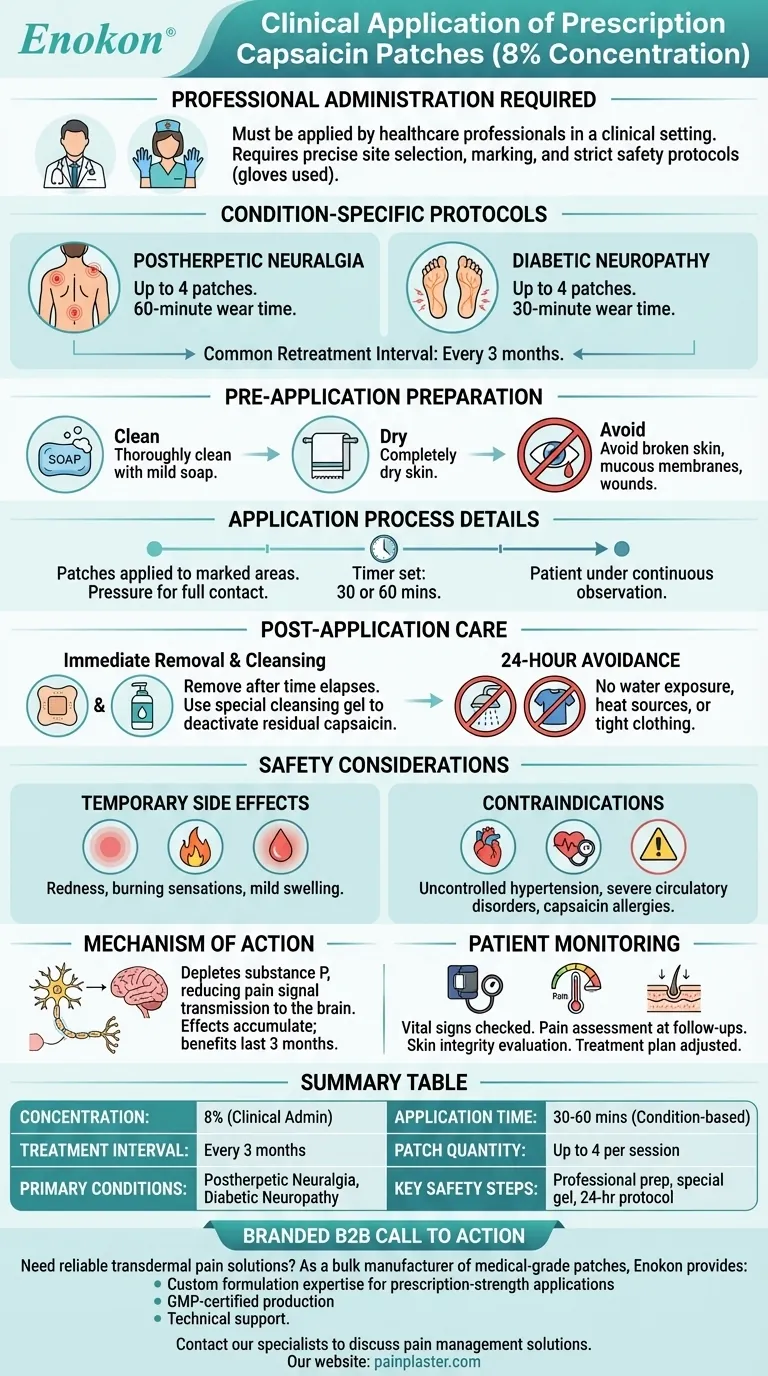Prescription Capsaicin Patch application is a specialized medical procedure performed by healthcare professionals to manage chronic nerve pain conditions like postherpetic neuralgia and diabetic neuropathy. The process involves careful site selection, precise application timing (30-60 minutes), and strict safety protocols to minimize skin irritation. These high-concentration (8%) patches are distinct from over-the-counter versions, requiring clinical supervision due to their potency and potential side effects. Treatment intervals are typically spaced every 3 months, with variations based on the specific condition being treated.

Key Points Explained:
-
Professional Administration Requirement
- Prescription-strength capsaicin patches (8% concentration) must be applied by doctors or nurses in clinical settings
- Healthcare providers:
- Select optimal application sites based on pain location
- Mark treatment areas to ensure proper placement
- Use gloves during handling to prevent accidental exposure
-
Condition-Specific Protocols
-
Postherpetic neuralgia:
- Up to 4 patches applied simultaneously
- 60-minute wear time per session
-
Diabetic neuropathy:
- Also up to 4 patches
- Shorter 30-minute application duration
- Both conditions share the same 3-month retreatment interval
-
Postherpetic neuralgia:
-
Pre-Application Preparation
- Skin must be:
- Thoroughly cleaned with mild soap
- Completely dried before patch placement
- Strict avoidance of:
- Broken/irritated skin areas
- Mucous membranes (eyes, nose, mouth)
- Recent wounds or dermatological conditions
- Skin must be:
-
Application Process Details
- Patches adhere directly to marked treatment areas
- Pressure applied to ensure full skin contact
- Timer set for precise wear duration (30 or 60 minutes)
- Patients remain under observation during entire application
-
Post-Application Care
- Immediate removal after prescribed time elapses
- Special cleansing gel used to deactivate residual capsaicin
- 24-hour avoidance of:
- Water exposure (bathing/swimming)
- Heat sources near treated areas
- Tight clothing over application sites
-
Safety Considerations
- Temporary side effects may include:
- Application-site redness
- Burning sensations
- Mild swelling
- Contraindications include:
- Uncontrolled hypertension
- Severe circulatory disorders
- Known capsaicin allergies
- Temporary side effects may include:
-
Mechanism of Action
- Capsaicin depletes substance P in nerve fibers
- Reduces transmission of pain signals to brain
- Effects accumulate over multiple treatments
- Therapeutic benefits typically last 3 months
-
Patient Monitoring
- Vital signs checked before/during application
- Pain assessment at follow-up visits
- Skin integrity evaluation post-removal
- Adjustment of treatment plan based on response
The clinical application of prescription capsaicin patches represents an innovative approach to chronic pain management, offering targeted relief without systemic drug exposure. While requiring specialized administration, these treatments provide sustained benefits for qualifying patients when properly implemented within comprehensive pain management protocols.
Summary Table:
| Key Aspect | Details |
|---|---|
| Concentration | 8% prescription strength (requires clinical administration) |
| Application Time | 30-60 minutes based on condition |
| Treatment Interval | Every 3 months |
| Patch Quantity | Up to 4 patches per session |
| Primary Conditions | Postherpetic neuralgia, Diabetic neuropathy |
| Key Safety Steps | Professional skin prep, special removal gel, 24-hour care protocol |
Need reliable transdermal pain solutions? As a bulk manufacturer of medical-grade patches, Enokon provides:
- Custom formulation expertise for prescription-strength applications
- GMP-certified production of therapeutic patches
- Technical support for clinical implementation
Contact our specialists to discuss pain management solutions for your patients or product line.
Visual Guide

Related Products
- Capsaicin Chili Medicated Pain Relief Patches
- Heat Relief Capsicum Patch for Lower Back Pain Relief
- Asthma Cough and Pain Relief Patch for Adults and Kids
- Far Infrared Deep Heat Relief Patches Medicated Pain Relief Patches
- Menthol Gel Pain Relief Patch
People Also Ask
- How do you apply the Signal Relief patch to find the proper placement? A Step-by-Step Guide to Maximum Relief
- How do pain relief patches work? A Guide to Targeted, Long-Lasting Pain Relief
- Are pain relief patches safe for sensitive skin? Your Guide to Safe Use & Skin Testing
- What is the purpose of capsaicin patches? A Guide to Temporary Pain Relief
- What side effects might occur from using capsaicin patches? Understand the difference between normal sensation and danger signs.















